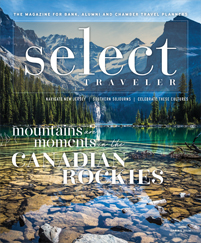From Railcars to Watercolors
This is a city that prioritizes preservation, so it’s not surprising its civic leaders found a new use for an old train-car factory just off Main Street near the river.
The Foundry Art Centre showcases a World War II-era structure that built railcars, and a massive crane used for that purpose remains suspended above the lobby. Resident artists line each wall on the second floor, and galleries on the ground level welcome visitors. Interactive workshops are available year-round, and the Foundry Arts Centre is a focal point for the city’s Mosaics Festival for the Arts each September.
“This is a beautiful facility to work in, and most of us make ourselves accessible to visitors,” said artist Ann Croghan, who has painted and taught in the center for six years. “I’ve sold art to visitors from out of town — just last week a couple came back in and bought a piece they looked at a year ago.”
That evening, Elizabeth Phelps, assistant director for the St. Charles bureau, took me to dinner at Prasino in the city’s new urban-living district, Streets of St. Charles. This busy development is an alter ego to Main Street, and I enjoyed the trendy change of pace with scores of other diners and residents who made this Tuesday evening feel like a Friday night.
Cyclists and Car Buffs
My second day in St. Charles began with breakfast at ground zero for the city’s cycling guests, the Bike Stop Café. Phelps and I sat with owner Tony Caruso to talk about the popularity of cycling in this area. His cafe is housed in a historic warehouse just off the river, and cyclists were already gathering for early morning rides.
The Katy Trail stretches westward from St. Charles almost to Kansas City. Many visitors to St. Charles rent bikes from the Bike Stop Café and do one-day rides into Missouri’s wine region. Others do much longer trips.
“We get cyclists from Kentucky, Arkansas, Missouri and other states,” said Caruso. “Some of them come in small groups, and they’re coming for a week or more on the trail. There are B&Bs along the way, and most people just get online and set it up themselves. September is prime time; the weather is perfect then.”
Caruso is an active voice in the city’s tourism scene.
“This downtown is very vibrant,” he said. “There are growing opportunities every year in St. Charles for new things to do.”
“The historic district is very charming,” said Phelps afterward, “but interestingly enough, there is a strong tech sector there, too. Visitors wouldn’t necessarily realize that. We have several start-ups active there currently.”
My itinerary called for trips to Daniel Boone’s home and Missouri wine country after our breakfast stop, but Phelps inserted a stop to one of the coolest car places I’ve ever seen: Fast Lane Classic Cars is like a car museum, except the exhibits are for sale. Rows and rows of artfully restored muscle cars, foreign sports cars and vintage ’vettes are available for viewing — and for taking home.
“We’re bringing more people here all the time,” said Phelps. “It’s such an amazing collection of cars; there is no admission charge, and they welcome guests from out of town. When you think about it, why wouldn’t they? They’re selling these cars to people from all over the world.”
Pioneer to the End
Many Kentuckians like me have no idea what became of Boone after he crossed the Cumberland Gap to become the state’s most celebrated settler. So when Phelps offered me the chance to see where this early American icon spent the end of his life, I took it.
The Daniel Boone Home sits in a setting worthy of its namesake in what is now Missouri wine country on a hillside that gently slopes back to a distant creek below. Boone and his son cleared much of this property themselves.
Prominent from his time in Kentucky, Boone was named a judge for the territory and made his decisions from the base of his “judgment tree” near the home’s spring. A concrete casting of the tree was made years ago to preserve its place in history.
We toured the two-story stone house that included a basement kitchen beneath.
On the main floor, we peered into a bedroom that faced the front yard.
“Daniel Boone died in this room— 21 years after moving here — at the age of 86,” said our guide.
Phelps and I wrapped up my time in St. Charles with lunch at the Chandler Hill Winery, one of several wineries in this scenic countryside. I thought about the types of trips for groups Maxon had referenced the day before. I’d recommend the first. Stay in this historic city and work your way out from here. Any town that has drawn explorers like Boone and Lewis and Clark should probably draw a visit from your explorers, too.









